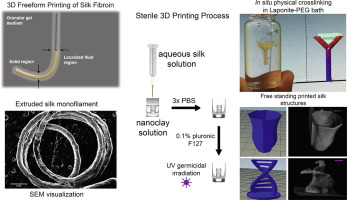Acta Biomaterialia ( IF 9.4 ) Pub Date : 2018-03-15 , DOI: 10.1016/j.actbio.2018.02.035 Maria J Rodriguez 1 , Thomas A Dixon 1 , Eliad Cohen 2 , Wenwen Huang 1 , Fiorenzo G Omenetto 1 , David L Kaplan 1

|
Freeform fabrication has emerged as a key direction in printing biologically-relevant materials and structures. With this emerging technology, complex structures with microscale resolution can be created in arbitrary geometries and without the limitations found in traditional bottom-up or top-down additive manufacturing methods. Recent advances in freeform printing have used the physical properties of microparticle-based granular gels as a medium for the submerged extrusion of bioinks. However, most of these techniques require post-processing or crosslinking for the removal of the printed structures ; . In this communication, we introduce a novel method for the one-step gelation of silk fibroin within a suspension of synthetic nanoclay (Laponite) and polyethylene glycol (PEG). Silk fibroin has been used as a biopolymer for bioprinting in several contexts, but chemical or enzymatic additives or bulking agents are needed to stabilize 3D structures. Our method requires no post-processing of printed structures and allows for in situ physical crosslinking of pure aqueous silk fibroin into arbitrary geometries produced through freeform 3D printing.
Statement of Significance
3D bioprinting has emerged as a technology that can produce biologically relevant structures in defined geometries with microscale resolution. Techniques for fabrication of free-standing structures by printing into granular gel media has been demonstrated previously, however, these methods require crosslinking agents and post-processing steps on printed structures. Our method utilizes one-step gelation of silk fibroin within a suspension of synthetic nanoclay (Laponite), with no need for additional crosslinking compounds or post processing of the material. This new method allows for in situ physical crosslinking of pure aqueous silk fibroin into defined geometries produced through freeform 3D printing.
中文翻译:

丝素蛋白的 3D 自由形态打印。
自由成型制造已成为打印生物相关材料和结构的关键方向。借助这项新兴技术,可以以任意几何形状创建具有微尺度分辨率的复杂结构,并且不受传统自下而上或自上而下增材制造方法的限制。自由形式印刷的最新进展利用基于微粒的颗粒凝胶的物理特性作为生物墨水浸没挤出的介质。然而,大多数这些技术需要后处理或交联以去除印刷结构; 。在本次交流中,我们介绍了一种在合成纳米粘土(Laponite)和聚乙二醇(PEG)悬浮液中一步凝胶化丝素蛋白的新方法。丝素蛋白已在多种情况下用作生物打印的生物聚合物,但需要化学或酶添加剂或填充剂来稳定 3D 结构。我们的方法不需要对打印结构进行后处理,并且允许将纯水性丝素蛋白原位物理交联成通过自由形式 3D 打印产生的任意几何形状。
重要性声明
3D 生物打印已成为一种能够以微尺度分辨率生产具有定义几何形状的生物相关结构的技术。通过打印到颗粒状凝胶介质中来制造独立式结构的技术先前已被证明,然而,这些方法需要交联剂和对打印结构进行后处理步骤。我们的方法利用合成纳米粘土(合成锂皂石)悬浮液中丝素蛋白的一步凝胶化,无需额外的交联化合物或对材料进行后处理。这种新方法允许将纯水性丝素蛋白原位物理交联成通过自由形式 3D 打印产生的确定的几何形状。











































 京公网安备 11010802027423号
京公网安备 11010802027423号